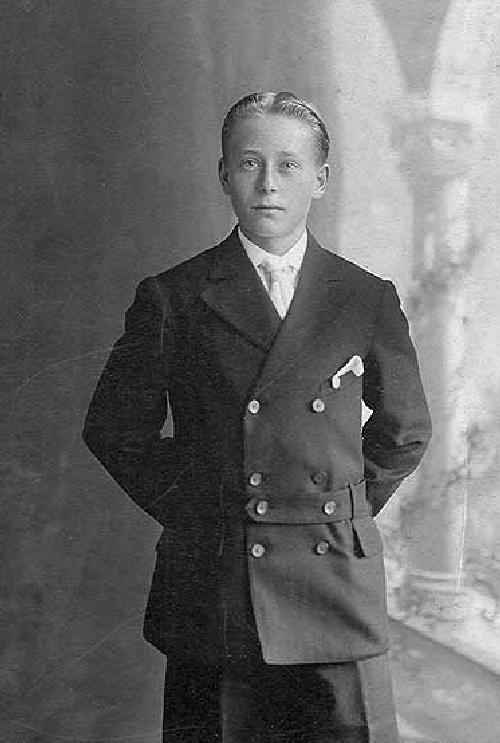
United States Boys' Suits: Colors

Figure 1.-- We see boys wearing suits in the late 19th century that were mostly done in patterns. We note a range of colors. Brown was very common, but we also note blue and grey and even green patterns of varying hues. After the turn of the 20th century, we see more boys wearing conservative solid-colored navy blue and black suits.
|
|
We see boys wearing suits in the late 19th century that were mostly done in patterns. We note a range of colors. Brown was very common, but we also note blue and grey and even green patterns of varying hues. We see white or very-light colored suits, but these were primarily for seasonal wear or special occassions. It is not possible to assess these colors in the black and white photographs of the day. A good ideas on colors, however, is available in store catalogs. The photographs if clear enough can show whether the boys are weaing suits with colors or solid colors. Here social class was a factor. The classic, dark solid colored suits were a conservative style referred by the upper class. Boys from more modest families would be more likely to wear the suits with patterns. The patterns were often, but not always muted. After the turn of the century we see many boys begin wearing dark-colored suits done in navy blue and black. These two colors became classic American suit colors. These seems much less common in Britain.
Chronology
Rather coinservative or muted colors have generally been preferredfor boys suits. Wecdo not yet have much chronological information. A oroblem here is that photography for many years was black-and-white. So we do not know the color of many of the suits boys are wering on the HBC pages.
We note John and Charles Howell in the 1860s wearing navy-blue suits in the 1860s. We also see black and white checked blouses with what may be black pants. Military-styled peaked caps surely are navy blue and not black.
We also note grey suits in the 1860s. One might have thought that the Civil War in which Federal troops wore blue uniforms and Confederate tropps grey or butternut would have affected the color of the suits boys wore, but this does not seem to have been the case. We notice William J. Walsh from Philadelphia in the North wearing a grey suit.
Patterns
We see boys wearing suits in the late 19th century that were mostly done in patterns. The pattens might mix dark colors.
We note a range of colors. Brown was very common, but we also note blue and grey and even green patterns of varying hues. We see white or very-light colored suits, but these were primarily for seasonal wear or special occassions. A good example is two unidentified boys wearing summer suits about 1920. It is not possible to assess these colors in the black and white photographs of the day. A good ideas on colors, however, is available in store catalogs. The photographs if clear enough can show whether the boys are weaing suits with colors or solid colors. Here social class was a factor. The classic, dark solid colored suits were a conservative style referred by the upper class. Boys from more modest families would be more likely to wear the suits with patterns. The patterns were often, but not always muted. After the turn of the century we see many boys begin wearing dark-colored suits done in navy blue and black. These two colors became classic American suit colors. These seems much less common in Britain.
HBC

Navigate the Boys' Historical Clothing Web Site:
[Return to the Main U.S. suits page]
[Return to the Main Norfolk suit country page]
[Introduction]
[Activities]
[Biographies]
[Chronology]
[Clothing styles]
[Countries]
[Bibliographies]
[Contributions]
[FAQs]
[Glossary]
[Images]
[Links]
[Registration]
[Tools]
[Boys' Clothing Home]
Created: 1:43 AM 4/3/2005
Last updated: 3:55 AM 10/11/2010



